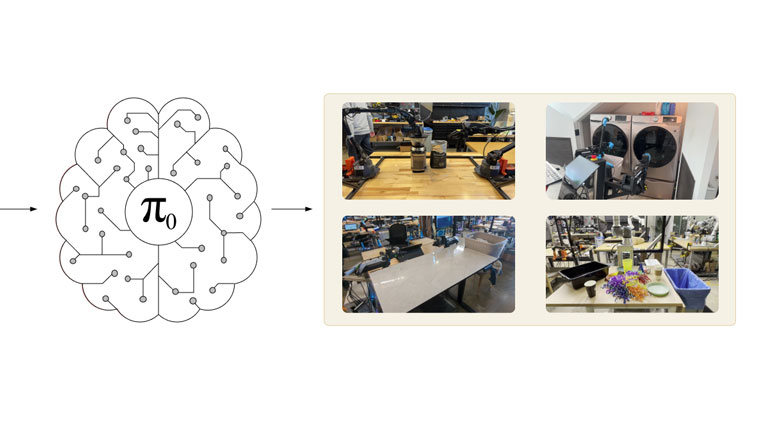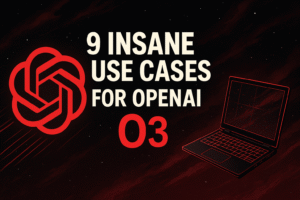In the fast-evolving world of robotics, a groundbreaking player has emerged: Physical Intelligence. The company is changing the game by taking robotics beyond the conventional boundaries of industrial and controlled environments.
Instead, they’re creating machines with a generalist robot policy that can adapt to complex physical challenges—a true first step towards artificial physical intelligence. In this article, we’ll dive into what makes Physical Intelligence’s robotic innovations truly revolutionary and why they matter for the future of autonomous AI.
Living Through an AI Revolution
We are living through an AI revolution. AI assistants are not only providing practical help in our daily lives, but now AI can even generate photo-realistic imagery, compose music, and predict the structure of proteins. Yet, for all of these advances, human intelligence still dramatically outpaces AI when it comes to interacting with the physical world.
This difference can be summarized with Moravec’s Paradox: the observation that tasks requiring basic sensorimotor skills, like folding laundry or cleaning up a table, are incredibly challenging for AI, while tasks requiring abstract reasoning are comparatively easier. The complexity of physically situated tasks requires more than algorithms—it requires machines that understand the world in a way that resembles human experience. That’s where Physical Intelligence comes in. With their new general-purpose robot, Pi-Z, they are developing what they call the first model of artificial physical intelligence. Much like large language models (LLMs) assist us today, Pi-Z could enable robots to autonomously carry out physically demanding tasks by processing visual, textual, and action-based data.
Explore how AI is transforming the workplace with Microsoft Co-Pilot Studio AI Agents
Generalist Robot Policies: Breaking the Limitations of Today’s Robotics
Current robots are narrow specialists, created to repeat a limited number of tasks in tightly controlled environments. Industrial robots, for example, are commonly used to perform repetitive actions in factories. Such behaviors are only achievable with extensive manual programming and are infeasible for more complex and unpredictable environments, such as homes.
To overcome these limitations, Physical Intelligence’s goal is to train a single, generalist robot policy—one that can adapt to new tasks with limited data, much as humans do. The company believes that by leveraging a lifetime’s worth of robot data, a generalist model could specialize in new tasks with only modest training. This general approach is comparable to how LLMs, such as OpenAI’s GPT-4, surpass more specialized language processing models by drawing on diverse, large-scale pre-training data.
Read more on the power of generalist models in AI development.
Introducing Pi-Z: The Foundation Model for Physical Intelligence
Pi-Z is Physical Intelligence’s prototype for embodied general-purpose robots. Similar to LLMs, Pi-Z was trained on broad and diverse data sources, integrating data from images, text, and physical actions. Unlike language models, Pi-Z directly outputs low-level motor commands, allowing it to control different types of robots.
One of Pi-Z’s key breakthroughs is its ability to autonomously perform tasks, such as folding a shirt—an incredibly complex action requiring flexibility, decision-making, and dexterity. Most robots require precise scripting for repetitive tasks, but Pi-Z can autonomously adjust its actions in response to the unpredictable nature of physical objects. Imagine a stack of tangled laundry: for a machine to fold it, the robot must consider countless scenarios—a challenge that Pi-Z is meeting head-on with impressive success.
The demo videos show robots autonomously folding clothing, busing tables, and assembling boxes—complex, multi-stage tasks that involve continuous adjustment and reasoning. Watch the demo videos here. Pi-Z’s success demonstrates a significant leap forward in robot dexterity, beyond what we’ve seen from other models in the past.
Cross-Embodiment Learning: How Pi-Z Handles Diverse Robots
Pi-Z employs a method called cross-embodiment training, which integrates data from multiple robots, resulting in a model that can handle tasks with great diversity and complexity. The tasks include actions such as folding laundry, packaging food, assembling cardboard boxes, and even busing tables by stacking dishes and separating trash—all autonomously. The robot leverages a combination of open-source robot manipulation datasets, internet-scale vision-language models, and Physical Intelligence’s own high-quality datasets, resulting in what might be the world’s most dexterous generalist robot to date.Check out Anthropic’s approach to AI and computer use in their Claude AI Beginner’s Guide.
Pi-Z in Action: Mastering Difficult Tasks
The most remarkable aspect of Pi-Z’s design is its ability to handle what are called “emergent capabilities”—that is, demonstrating skills without explicit training for each individual task. For instance, the robot has been trained to assemble a cardboard box by folding flaps and tucking edges while compensating for unexpected issues. Such adaptability highlights the promise of generalist models and their potential to go beyond the rigid structure of pre-programmed robots.
Take the example of table-busing. This process requires the robot to pick up dishes, sort them, and dispose of trash—all within one coherent routine. Pi-Z has developed unique strategies like stacking dishes or shaking trash off plates before putting them away, which mirrors human behavior closely. It’s this kind of nuanced decision-making that makes Pi-Z stand out as a breakthrough in physical robotics.
The Road Ahead: Scaling for the Future
While Pi-Z represents a groundbreaking development, the journey toward creating general-purpose robot models is still in its early stages. One current challenge is ensuring that Pi-Z can effectively navigate unpredictable environments, such as cluttered household settings, where unexpected obstacles can disrupt task completion. Physical Intelligence’s focus will be on tackling challenges such as long-horizon reasoning, autonomous improvement, robustness, and safety in robotic applications. By collaborating with various robotics labs and companies, they aim to refine hardware and integrate data from partner systems to expand the model’s capabilities further.
The future of AI will undoubtedly be shaped by these embodied robots that can not only think but also act in a manner that resembles humans. As Pi-Z continues to improve, it paves the way for a new age in robotics—one that bridges the gap between digital intelligence and the tangible, unpredictable physical world.
Learn More About the Power of AI for Marketing
Robotics and embodied AI are just one facet of the broader AI revolution. To understand how AI is transforming other industries, especially marketing, take a look at our post on AI for Marketing and its impact on digital content strategies.







